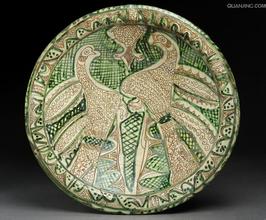Large dishes of this sort are known as Piatti di Pompa
這種大瓷盤被稱為龐帕碟
and designed to be displayed on a buffet rather than used
作為冷餐酒會的擺設(shè)品而不是用來盛放東西
Some later examples are pierced through the foot for a cord
后來的一些瓷器用繩索
to be threaded through allowing the piece
從底下刺穿過去
to be hung on the wall in the manner of a print
使其能夠像版畫那樣掛在墻上
The careful drawing on these dishes
這些瓷盤上細致的彩繪
and their moralizing inscriptions
及其說教式的文字
suggest that they play a role
表明他們既可以作為
as both presentation and display pieces
饋贈禮物和擺設(shè)的雙重作用

Another Deruta plate of this type
這一款式的另外一個德魯特盤子
made 1460-65
出產(chǎn)于1460到1465年間
deals with the theme of love's blindness
涉及的主題是愛的盲目
It shows an elegantly dressed young man
它上面描繪的是體態(tài)優(yōu)雅
in the latest court fashion
身著當(dāng)時最時髦的宮廷服飾的年輕男子
which enables a close dating for the plate
通過和注有日期的壁畫和油畫相比
by comparison with dating frescoes and paintings
該服飾有助于推斷這個盤子的更為確切的日期
He holds a scroll
他手持一個卷軸
which reads in translation
上面的文字翻譯過來后的意思是
"a lover thinks that everyone else is blind
"情人認為別人都是瞎了眼的
but really, it is he who sees little"
但實際上是他自己眼光很短淺"
This ironic and popular motto
這個極具諷刺意味同時又很流行的箴言
presents the infatuated young man
表達出了這個被戀愛沖昏了頭的年輕男子
as a figure of fun
這樣一個可笑的人物
but maybe derived from a contemporary print
但可能源于當(dāng)代的一幅版畫
as yet unidentified
這未曾得知
Much more sophisticated
更為復(fù)雜而撩人心緒的
and disturbing is this dish
要數(shù)這個來自大都會的盤子了
in the Metropolitan, painted in Giordio in 1522
它于1522年在基爾吉奧進行彩繪
The scene is set in a landscape
畫面上的場景設(shè)在一個景觀之中
and shows a heated argument
展現(xiàn)的是一對盛裝打扮的
between a well-dressed young couple
年輕夫婦之間的激烈辯論
The woman holds a knife in her right hand
這位女子右手手持一把小刀
she points at her lover, who she's tied to a tree
她將小刀對著被其綁在樹上的愛人
She appears to address him in her fury
在生氣之下
as she advances towards him
她在向他靠近的過程中滔滔不絕
He looks away towards the viewer
他將目光投向旁觀者
A cartouche in the foreground is painted with the arms of
前景中的一個渦卷裝飾描繪了主角的臂章
a patron and the inscription
和一行文字
"your infamy hurts me more than death"
“你的惡名傷害了我 讓我生不如死"
The interpretation of the scene remains mysterious
關(guān)于這個場景的解釋至今仍是謎團
In some elements in reveals that in the early Florentine engraving
有些元素表明 這幅收藏于大英博物館的
in the British Museum here
佛羅倫薩的早期版畫中
in which a woman has tied her lover to a tree
一位女子將其愛人捆綁在了一棵樹上
and has plucked his heart from his breast
并從他的胸部摘下心臟
signifying the cruelty and vulnerability of love
這象征著愛情的殘忍和脆弱
But the inscription adds layers of complexity
但是上面的題字又增加了其復(fù)雜性
if it is a young man who is threatened at the hand of his lover
如果是一個受到愛人威脅的年輕男子
then it must be he who's speaking
那么這些字眼應(yīng)該是他講的
in which case, the infamy must be due to the woman
這樣的話 這個惡名就應(yīng)該是這個女子的
The scene and inscription might perhaps be
這個場景和文字
based on a contemporary print
可能是基于一幅當(dāng)代版畫
or a yet to be identified
或者是一個有待確認的
or possibly on a romance
或者可能和某個傳奇故事有關(guān)
as is sometimes suggested
因為這在馬爵利卡陶瓷上的
in the case of other representations
有關(guān)愛情爭吵主題的其它代表作中
of love arguments on maiolica
偶爾也出現(xiàn)過
The arms which have been
經(jīng)初步確認
tentatively identified as
這些臂章是圖拉米·盧森尼亞時期的
those of Turami Lusenia and lots of pieces
在劍橋和巴黎有很多這樣的瓷器
in Cambridge and Paris
出自同一個畫師之手
which are painted by the same painter and dated 1522
均可追溯至1522年











